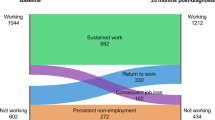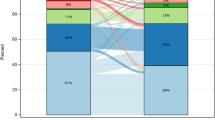Abstract
Purpose Women undergoing diagnosis and treatment for breast cancer may face challenges in employment. We investigated the impact of demographic, clinical, workplace, and psychosocial characteristics on loss of employment after a breast cancer diagnosis and treatment. We further describe changes in work status and work environment for cancer survivors who sustain employment. Methods We analyzed responses from a survey of breast cancer survivors from the Sister Study and the Two Sister Study cohorts who reported being employed at the time of their breast cancer diagnosis and who reported employment status (lost vs. sustained employment) at the time of survey administration. Multivariate logistic regression was used to identify the effects of lymphedema, neuropathy, problems with memory or attention, social support, health insurance, and sick leave on lost employment, adjusting for demographic characteristics, cancer stage, treatment, and general health. Results Of the 1675 respondents who reported being employed at the time of diagnosis, 83.5% reported being ‘currently’ employed at the time of the survey. Older age, peripheral neuropathy, lack of sick leave, late stage at diagnosis, a recurrence or a new cancer, problems with memory or attention, and poor general health were significantly associated with lost employment. Conclusions The long-term effects of breast cancer treatment and workplace provisions for leave and accommodation may have a substantial effect on women’s ability to sustain employment. The findings from this study highlight challenges reported by cancer survivors that may inform clinical and occupational interventions to support survivors’ return to work.

Similar content being viewed by others
References
National Cancer Institute, Surveillance E, and End Results (SEER). Cancer stat facts: female breast cancer. https://seer.cancer.gov/statfacts/html/breast.html. Accessed 10 Mar 2020
Weir HK, Thompson TD, Soman A, Møller B, Leadbetter S. The past, present, and future of cancer incidence in the United States: 1975 through 2020. Cancer. 2015;121(11):1827–37.
Miller KD, Siegel RL, Lin CC, et al. Cancer treatment and survivorship statistics. CA Cancer J Clin. 2016;66(4):271–89.
de Boer AM, Taskila T, Ojajärvi A, van Dijk FH, Verbeek JM. Cancer survivors and unemployment: a meta-analysis and meta-regression. JAMA. 2009;301(7):753–62.
Fu AZ, Chen L, Sullivan S, Christiansen NP. Absenteeism and short-term disability associated with breast cancer. Breast Cancer Res Treat. 2011;130:235–42.
Banning M. Employment and breast cancer: a meta-ethnography. Eur J Cancer Care. 2011;20:708–19.
Blinder VS, Murphy MM, Vahdat LT, et al. Employment after a breast cancer diagnosis: a qualitative study of ethnically diverse urban women. J Commun Health. 2012;37(4):763–72.
de Boer AGEM, Taskila TK, Tamminga SJ, Feuerstein M, Frings-Dresen MHW, Verbeek JH. Interventions to enhance return-to-work for cancer patients. Cochrane Database Syst Rev. 2015;2015(9):007569.
Spelten ER, Sprangers MAG, Verbeek JHAM. Factors reported to influence the return to work of cancer survivors: a literature review. Physcooncology. 2002;11(2):124–31.
de Boer AGEM, Frings-Dresen MHW. Employment and the common cancers: return to work of cancer survivors. Occup Med. 2009;59(6):378–80.
Livestrong Foundation. Survivors’ experiences with employment. A Livestrong brief 2013. www.LIVESTRONG.ore/we-can-help/managing-your-life-during-treatment/employment-issues/. Accessed 16 Nov 2019.
Islam T, Dahlui M, Majid HA, Nahar AM, Mohd Taib NA, Su TT. Factors associated with return to work of breast cancer survivors: a systematic review. BMC Public Health. 2014;14(3):S8.
Sun Y, Shigaki CL, Armer JM. Return to work among breast cancer survivors: a literature review. Support Care Cancer. 2017;25(3):709–18.
Tamminga SJ, Braspenning AM, Haste A, Sharp L, Frings-Dresen MHW, de Boer AGEM. Barriers to and facilitators of implementing programs for return to work (RTW) of cancer survivors in four European countries: a qualitative study. J Occup Rehabil. 2019;29(3):550–9.
Silver JK, Baima J, Mayer RS. Impariment-driven cancer rehabilitation: an essential component of quality care and survivorship. CA Cancer J Clin. 2013;63:295–317.
Yabroff KR, McNeel TS, Waldron WR. Helath limitations and quality of life associated with cancer and other chronic diseases by phase of care. Med Care. 2007;45:629–37.
Balak F, Roelen CAM, Koopmans PC, ten Berge EE, Groothoff JW. Return to work after early-stage breast cancer: a cohort study into the effects of treatment and cancer-related symptoms. J Occup Rehabil. 2008;18(3):267–72.
Duijts SFA, van Egmond MP, Spelten E, van Muijen P, Anema JR, van der Beek AJ. Physical and psychosocial problems in cancer survivors beyond return to work: a systematic review. Psycho-Oncology. 2014;23(5):481–92.
Eaker S, Wigertz A, Lambert PC, et al. Breast cancer, sickness absence, income and marital status. A study on life situation 1 year prior diagnosis compared to 3 and 5 years after diagnosis. PLoS ONE. 2011;6(3):e18040.
Fantoni SQ, Peugniez C, Duhamel A, Skrzypczak J, Frimat P, Leroyer A. Factors related to return to work by women with breast cancer in Northern France. J Occupat Rehabil. 2010;20(1):49–58.
Hassett MJ, O’Malley AJ, Keating NL. Factors influencing changes in employment among women with newly diagnosed breast cancer. Cancer. 2009;115(12):2775–82.
Timperi AW, Ergas IJ, Rehkopf DH, Roh JM, Kwan ML, Kushi LH. Employment status and quality of life in recently diagnosed breast cancer survivors. Psycho-Oncology. 2013;22(6):1411–20.
van Muijen P, Duijts SFA, van der Beek AJ, Anema JR. Prognostic factors of work disability in sick-listed cancer survivors. J Cancer Surviv. 2013;7(4):582–91.
Jagsi R, Hawley ST, Abrahamse P, et al. Impact of adjuvant chemotherapy on long-term employment of early stage breast cancer survivors. Cancer. 2014. https://doi.org/10.1002/cncr.28607.
Fuerstein M, Todd BL, Moskowitz MC, et al. Work in cancer survivors: a model for practice and research. J Cancer Surv. 2010;4:414–37.
Bouknight RR, Bradley CJ, Luo Z. Correlates of return to work for breast cancer survivors. J Clin Oncol. 2006;24(3):345–53.
Ekenga CC, Perez M, Margenthaler JA, Jeffe DB. Early-stage breast cancer and employment participation after 2 years of follow-up: a comparison with age-matched controls. Cancer. 2018;124:2026–35.
Carlsen K, Jensen AJ, Rugulies R, et al. Self-reported work ability in long-term breast cancer survivors. A population-based questionnaire study in Denmark. Acta Oncol. 2013;52(2):423–9.
Caron M, Durand M-J, Tremblay D. Perceptions of breast cancer survivors on the supporting practices of their supervisors in the return-to-work process: a qualitative descriptive study. J Occup Rehabil. 2018;28(1):89–96.
Blinder V, Patil S, Eberle C, Griggs J, Maly RC. Early predictors of not returning to work in low-income breast cancer survivors: a 5-year longitudinal study. Breast Cancer Res Treat. 2013;140(2):407–16.
Fei C, Deroo LA, Sandler DP, Weinberg CR. Fertility drugs and young-onset breast cancer: results from the two sister study. J Natl Cancer Inst. 2012;104(13):1021–7.
Sandler DP, Hodgson ME, Deming-Halverson SL, et al. The sister study cohort: baseline methods and participant characteristics. Environ Health Perspect. 2017;125(12):127003.
Anderson C, Islam JY, Elizabeth Hodgson M, et al. Long-term satisfaction and body image after contralateral prophylactic mastectomy. Ann Surg Oncol. 2017;24(6):1499–506.
Buchanan ND, Dasari S, Rodriguez JL, et al. Post-treatment neurocognition and psychosocial care among breast cancer survivors. Am J Prev Med. 2015;49(6 Suppl 5):S498–508.
Hawkins Bressler L, Mersereau JE, Anderson C, et al. Fertility-related experiences after breast cancer diagnosis in the sister and two sister studies. Cancer. 2019;125(15):2675–83.
Pew Research Center. The State of American jobs: how the shifting economic landscape is reshaping work and society and affecting the way people think about the skills and training they need to get ahead. https://www.pewsocialtrends.org/wp-content/uploads/sites/3/2016/10/ST_2016.10.06_Future-of-Work_FINAL4.pdf. Accessed 16 Oct 2019
Yoe J. Why are older people working longer? Monthly Labor Review Bureau of Labor Statistics. June 2019.
Bradley CJ, Brown KL, Haan M, et al. Cancer survivorship and employment: intersection of oral agents, changing workforce dynamics, and employers’ perspectives. J Natl Cancer Inst. 2018;110:1292–9.
Ahles TA, Root JC, Ryan EL. Cancer- and cancer treatment-associated cognitive change: an update on the state of the science. J Clin Oncol. 2012;30(30):3675–86.
Koppelmans V, Breteler MMB, Boogerd W, Seynaeve C, Gundy C, Schagen SB. Neuropsychological performance in survivors of breast cancer more than 20 years after adjuvant chemotherapy. J Clin Oncol. 2012;30(10):1080–6.
Hershman DL, Lacchetti C, Loprinzi CL. Prevention and management of chemotherapy-induced peripheral neuropathy in survivors of adult cancers: American Society of Clinical Oncology clinical practice guideline summary. J Clin Oncol. 2014;10(6):e421–4.
Rivera DR, Ganz PA, Weyrich MS, Bandos H, Melnikow J. Chemotherapy-associated peripheral neuropathy in patients with early-stage breast cancer: a systematic review. J Natl Cancer Inst. 2018;110(2):djx140. https://doi.org/10.1093/jnci/djx140.
Winters-Stone KM, Horak F, Jacobs PG, et al. Falls, functioning, and disability among women with persistent symptoms of chemotherapy-induced peripheral neuropathy. J Clin Oncol. 2017;35(23):2604–12.
Johnsson A, Fornander T, Rutqvist L-E, Vaez M, Alexanderson K, Olsson M. Predictors of return to work ten months after primary breast cancer surgery. Acta Oncol. 2009;48(1):93–8.
DiSipio T, Rye S, Newman B, Hayes S. Incidence of unilateral arm lymphodema after breast cancer: a systematic review and meta-analysis. Lancet Oncol. 2013;14(6):500–15.
Gillespie TC, Sayegh HE, Brunelle CL, Daniell KM, Taghian AG. Breast cancer-related lymphedema: risk factors, precautionary measures, and treatments. Gland Surgery. 2018;7(4):379–403.
Magno S, Filippone A, Forcina L, Maggi L, Ronconi G, Amabile E, Ferrera PE. Physical rehabilitation after breast cancer. Transl Cancer Res. 2018;7:S351–5.
Norman SA, Localio AR, Potashnik SL, et al. Lymphedema in breast cancer survivors: incidence, degree, time course, treatment, and symptoms. J Clin Oncol. 2009;27(3):390–7.
Kent EE, de Moor JS, Zhao J, Ekwueme DU, Han X, Yabroff KR. Staying at one’s job to maintain employer-based health insurance among cancer survivors and their spouses/partners. JAMA Oncol. 2020;6(6):929–32.
Sawyer M, Spencer D. On the definition of involuntary unemployment. J Soc Econom. 2008;37(2):718–35.
Buchanan TW. Retrieval of emotional memories. Psychol Bull. 2007;133(5):761–79.
de Boer AGEM, Verbeek JHAM, Spelten ER, et al. Work ability and return-to-work in cancer patients. Br J Cancer. 2008;98(8):1342–7.
Stout NL, Alfano CM, Belter CW, et al. A bibliometric analysis of the landscape of cancer rehabilitation research (1992–2016). J Natl Cancer Inst. 2018;110(8):815–24.
Funding
This research was funded, in part, by the Intramural Research Program of the NIH, National Institute of Environmental Health Sciences (Z01 ES-044005). The findings and conclusions in this report are those of the authors and do not necessarily represent the official position of the Centers for Disease Control and Prevention. Web site addresses of nonfederal organizations are provided solely as a service to readers. Provision of an address does not constitute an endorsement of this organization by CDC or the federal government, and none should be inferred. CDC is not responsible for the content of other organizations’ Web pages.
Author information
Authors and Affiliations
Corresponding author
Ethics declarations
Conflict of interest
The authors declare that they have no conflict of interest.
Ethical Approval
This project received IRB approval.
Informed Consent
Informed consent was obtained from all individual participants included in the study.
Additional information
Publisher's Note
Springer Nature remains neutral with regard to jurisdictional claims in published maps and institutional affiliations.
Rights and permissions
About this article
Cite this article
Peipins, L.A., Dasari, S., Rodriguez, J.L. et al. Employment After Breast Cancer Diagnosis and Treatment Among Women in the Sister and the Two Sister Studies. J Occup Rehabil 31, 543–551 (2021). https://doi.org/10.1007/s10926-020-09951-6
Accepted:
Published:
Issue Date:
DOI: https://doi.org/10.1007/s10926-020-09951-6




